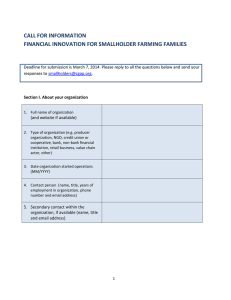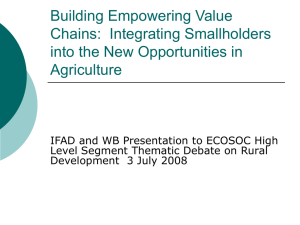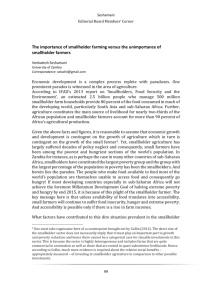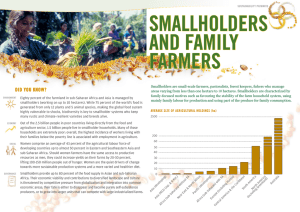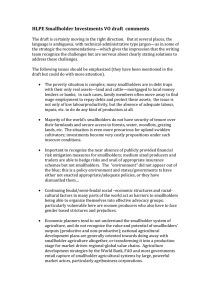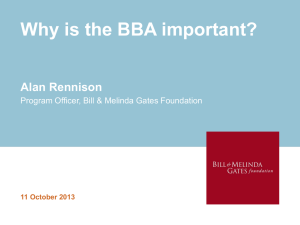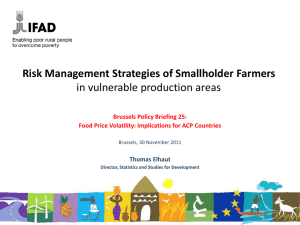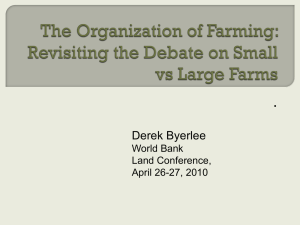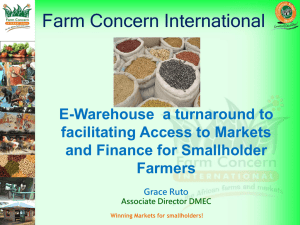The Economic Lives of Smallholder farmers in the Global integration
advertisement
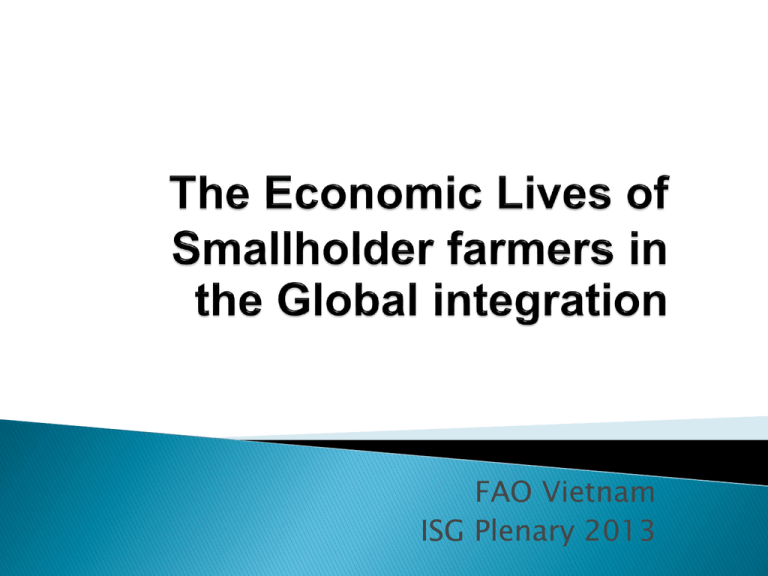
FAO Vietnam ISG Plenary 2013 Who are they? What are the determinants of smallholder participation in markets? How can smallholders be integrated into markets? What policies are required to support smallholder market integration? About two-thirds of the developing world’s 3 billion rural people live in about 425 million smallholder farm households ◦ many are poor, food insecure and malnourished with limited access to inputs and markets This is a rough estimate – defines smallholders as those who farm 2 hectares or less ◦ China: 98% of farmers cultivate 2 Ha or less; India: 80%; Ethiopia and Egypt: 90%; Mexico: 50%; Brazil: 20% ◦ other definitions: hectare weighted median farm threshold/family labour and family farm Proportion of food produced by smallholders They are the backbone of agricultural sector – produce the bulk of food They do many other things – on average off farm sources of income account for more than 50 percent of rural income Non-farm activities are quite important ◦ Self employment outside agriculture, commercial activities and remittances are major sources of income 100% 90% 80% 70% 60% 50% 40% 30% 20% 10% 0% Guatemala (42.34) Kenya (1.21) Malawi (1.00) Smallholder agriculture Nepal (1.18) Nicaragua (35.21) Other agriculture Pluriactivity Vietnam (1.22) • • Smallholder agriculture practiced by a highly heterogeneous group of producers Markets into which they sell are also diverse ⁃ Size, location, connectivity, governance • Smallholder heterogeneity along 3 dimensions: – Access to productive assets vs. subsistence needs – Connectivity to different markets – Functionality of these markets • Patterns of participation differ significantly – Policy interventions to support participation need to account for these differences Changing markets require scale Changes in markets have been significant ◦ globalization & urbanization have resulted in changes in food and input supply chains Sophisticated sales channels require: ◦ greater managerial and logistics skills ◦ continuity of supply and to meet demanding food safety and quality requirements Modern technology is becoming increasingly private: ◦ management skills and effective learning Changing nature of food markets – Shift from self-provisioning/informal markets to commercial orientation as economy develops – Combination of growing demand and commercial supply reaches a scale that induces emergence of modern marketing channels • Grading and standards; interlinked contracts; greater geographic reach etc – Formal and informal coexist in space and time • Market formalization, but informal markets still highly relevant Market integration: High transport costs in conjunction with small volumes limit participation ◦ informal smallholder groups or cooperatives may offer a solution Capital assets important to exploit market opportunities ◦ irrigation to meet consistency requirements ◦ storage Credit markets: Banks are reluctant to lend to smallholders due to poor collateral and lack of information Women small farmers face even greater disadvantages Barrett’s framework Four stages of “contracting”: ◦ Geographical sourcing assessment of candidate supply location ◦ Choice of Farmer identification of farmers in chosen location ◦ Farmer choice to accept ◦ Firm and farmer choice to honour contract The future of smallholders No ‘single’ or deterministic future for smallholders ◦ Governments will shape the future path ◦ family farms are the dominant firm in agriculture ◦ large corporate farms arise due to availability of land / low population density / weak property rights To stay in agriculture or not? They choose the best available option in a constrained environment ◦ often rural labour markets do not function well – low skills ◦ food security considerations: staying in agriculture is often a risk reducing option ◦ migration has become an important option – SOFI 2013 many governments restrict rural-urban migration flows from rural to Staying in smallholder agriculture In agriculture, smallholders have to make numerous decisions and these are not separable ◦ missing/poorly functioning markets link production, and consumption decisions, but also decisions on social objectives e.g. in Sub Saharan Africa, farmers sell most of their produce at the end of harvest (at low prices) to pay the school fees Decision making depends on government interventions to improve markets and livelihoods Interventions differ according to development stage, and the farm structure ◦ in low income countries with large number of small holder farms, policies should aim at productivity increases ◦ countries with a dual farm structure face more difficult dilemmas – social protection safety nets Smallholders’ choices and social protection Many programmes originate in the social sector ◦ targeting the ultra-poor, labour-constrained households, or households caring for vulnerable children Cash transfer programmes also influence the productive dimension ◦ livelihoods of most beneficiaries are based on subsistence agriculture and rural labour markets Transfers can relax some of constraints brought on by market failure (lack of access to credit, insurance) help smallholders to make choices ◦ accumulation of productive assets; investment in productive activities ◦ helping households manage risk; providing households with liquidity Institutional solutions Technological solutions Catalysts • A role for cooperative action? – Reduce transaction costs – Breach market thresholds – Facilitate access to inputs – Reduce risks/facilitate specialization • Numerous success cases, but also many examples showing impacts limited in scale and scope • Role for intergroup relations/networks • Support services and level of market development – Market related infrastructure and basic services – Storage, extension, seasonal credit – Market institutions – MIS, WRS, certification/food safety bodies • Risk management • Risk management instruments constrained by geographical dispersion, scale, standardization, quality • Tend to use informal mechanisms which can be ineffective for risk pooling • Intra-household transfers, cooperatives • A more proactive role for the state – Goes beyond the “enabling environment” – Markets don’t naturally improve their performance with the passing of time and the absence of public sector support – Facilitating role working with, and through, the private sector • Foster private sector investments in market development (the missing middle?) – Coordinated investments by VC stakeholders – Domestic vs FDI • The international community – Support development of principles – Formulation of international agreements – Crafting improved trade rules – Improved governance systems (coordination) • Policy set aligned with longer term development strategy needs to take a dynamic perspective • Different categories of smallholders will follow, by choice or compulsion, different pathways - not all will seek to increase production for sale in markets • Smallholder participation as a constrained choice • Choice dependent on ability and willingness to participate • Need to target to ensure appropriate emphasis and sequencing • Sequential alleviation of critical constraints • Level of intervention depends on level of integration Smallholders’ participation in markets important for improved food security and poverty reduction Attempts to improve smallholder productivity will have limited success if participation not strengthened simultaneously Limited smallholder participation in markets is not necessarily a result of a lack of commercial orientation per se, but the result of constrained choice in a risky environment Smallholders are very heterogeneous, facing different constraints and opportunities, and will react differently to new market opportunities Public policy interventions are needed to foster smallholder market integration Policy interventions need to be prioritized and sequenced according to evidence-based diagnosis of the constraints faced by different categories of smallholders
